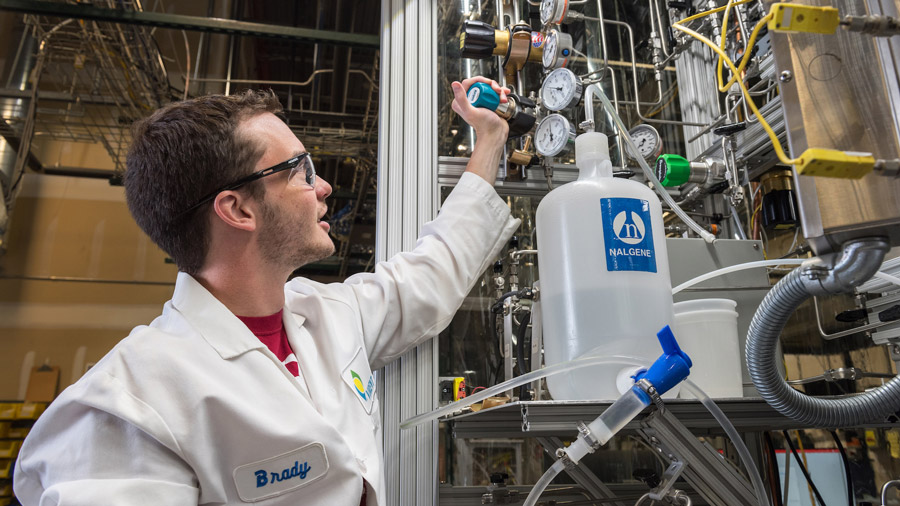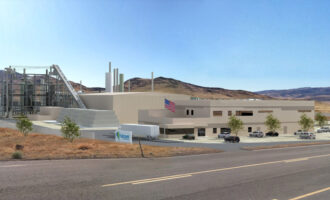
Sustainable aviation fuels: Scalable or greenwashing?
Air travel contributes around 2.5% of global carbon dioxide (CO2) emissions. Admittedly, this is a far smaller share than the likes of passenger cars and energy production. Though, demand for air travel is rising quickly, and so are its emissions. In 2018, nearly 4.4 billion passengers were carried by the world’s airlines with the associated flights emitting 895 million tonnes of CO2. Passenger numbers are projected to reach 8.2 billion by 2037, according to an analysis by the International Air Transport Association (IATA).
The aviation industry is committed to combating climate change and has undertaken to reduce aviation carbon emissions by 50% in 2050, from 2005 levels. But as demand for air travel continues to soar, how will the industry effectively reduce its carbon footprint?
A reduction in the number of flights is a fashionable response to mounting emissions. Electric or hybrid planes are another imagined solution. However, each of these outcomes offers a dream rather than a reality in the foreseeable future. Sustainable aviation fuels (SAF) present the most practical immediate step towards a sustainable outlook, formulated from renewable sources and mixed with conventional jet fuel.
On 24 February 2008, the first commercial aircraft, a Virgin Atlantic B747, was powered by a blend of conventional jet fuel and SAF. In 2017, there were more than 100,000-SAF blended flights, according to IATA.

SAF can be blended at a ratio of up to 50% with conventional jet fuel. Once blended, the fuel possesses the same characteristics as the fossil-based alternative and can be used on any plane certified for the principal Jet A or Jet A-1 fuel specifications. The blended fuels can also be handled without modification to existing infrastructure. What’s more, IATA claims SAF can elicit a reduction in CO2 emissions of up to 80%, while other producers like Velocys cite the potential for greater than 100% through the integrated sequestration of carbon from the production process.
With a seemingly easy transition to sustainable fuels available and minimal infrastructure investment required for airlines (but not for the SAF producer), one might ask why not all airlines are adopting SAFs? Currently, SAF contributes less than 0.1% of total aviation fuels consumed globally. Although, a ramp-up in the implementation of alternative fuels may be just around the corner.
Shell Aviation is the latest aviation services provider to announce plans for a greater application of SAF. On 7 January 2020, the company revealed a collaboration with World Energy to develop a scalable supply of SAF. World Energy is one of the largest advanced biofuel suppliers in North America and built the first commercial SAF facility in the world. As part of the briefing, Shell confirmed the supply of SAF to the Lufthansa Group at San Francisco International Airport (SFO), a deal that involves up to one million gallons of SAF. The fuel will be used by Deutsche Lufthansa and Swiss International Air Lines on three routes from SFO to Frankfurt and Munich, Germany, and Zurich, Switzerland.
The Shell Aviation announcement is one of several industry developments in the last couple of years as airlines look for opportunities to reduce their carbon intensity. In 2016, BP announced a strategic partnership between Air BP and Fulcrum BioEnergy, a pioneer in the development and production of low-carbon jet fuel, which included a 10-year offtake agreement for up to 50 million gallons per year. Fulcrum Energy’s Sierra Biofuels Plant, located in Reno, Nevada, is expected to begin commercial operations in 2020.
 More recently, BP entered into an agreement with one of the world’s leading producers of renewable fuels from wastes and residues, Neste, to deliver SAF to Swedish airline and airport customers. On 6 June 2019, the international aviation fuel products and services supplier announced it was delivering sustainable fuels to Swedish airport operator Swedavia. SAF will be primarily employed to offset the carbon impact of staff travel.
More recently, BP entered into an agreement with one of the world’s leading producers of renewable fuels from wastes and residues, Neste, to deliver SAF to Swedish airline and airport customers. On 6 June 2019, the international aviation fuel products and services supplier announced it was delivering sustainable fuels to Swedish airport operator Swedavia. SAF will be primarily employed to offset the carbon impact of staff travel.
As of September 2019, BP has supplied SAF in 15 locations across five countries. However, the BP website emphasizes that increasing production requires “long-term policy certainty to reduce investment risks, as well as a focus on the research, development and commercialization of improved production technologies and innovative sustainable feedstocks.”
Virent is another innovative company developing low carbon fuels that the world is increasingly demanding. The company’s patented Bioforming process offers a “drop-in” synthetic aromatic kerosene, produced from renewable sources, that can be blended with other types of synthetic jet fuel. The technology uses the carbohydrate portion of a plant and a catalytic process offers flexibility in the selection of feedstocks. Corn starch is the likely feedstock for the company’s first commercial plant, says Dave Kettner, president and general counsel at Virent. “The strategy is to build assets at scale using first-generation sugars as feedstock with the capability to implement cellulosic feedstocks when they become available,” he says.
Virent, which is a wholly-owned subsidiary of Marathon Petroleum Corporation, is one of several companies pursuing the approval of conversion pathways from the aviation industry. The Wisconsin, U.S.A.-based company’s application is awaiting final comments on its phase one report, and direction for phase two.
 The Commercial Aviation Alternative Fuels Initiative (CAAFI) is a coalition of airlines, aircraft and engine manufacturers, energy producers, researchers, international participants and U.S. government agencies. To date, five conversion pathways have been approved by the industry and added to ASTM D7566 as annexes, says Steve Csonka, CAAFI executive director. In addition, ARA’s Catalytic Hydrothermolysis Jet (CHJ) conversion pathway will be released imminently as Annex A6. A qualified pathway for co-processing in existing refineries also exists, with another pending approval, although those definitions are added to ASTM D1655, not D7566, confirms Csonka.
The Commercial Aviation Alternative Fuels Initiative (CAAFI) is a coalition of airlines, aircraft and engine manufacturers, energy producers, researchers, international participants and U.S. government agencies. To date, five conversion pathways have been approved by the industry and added to ASTM D7566 as annexes, says Steve Csonka, CAAFI executive director. In addition, ARA’s Catalytic Hydrothermolysis Jet (CHJ) conversion pathway will be released imminently as Annex A6. A qualified pathway for co-processing in existing refineries also exists, with another pending approval, although those definitions are added to ASTM D1655, not D7566, confirms Csonka.
Several other companies are pursuing approvals from the aviation industry for additional conversion processes including: an expansion of the allowable feedstocks in ASTM D7566 Annex A2 from IHI; the consideration of renewable diesel as a blending component from Neste and Boeing; and the consideration of mixed alcohols as an acceptable feedstock for ATJ-SPK (D7566 Annex A5) from Swedish Biofuels. Shell is seeking a new D7566 Annex for Integrated Hydropyrolysis and Hydroconversion (IH2) of a broad range of feedstocks, and Global Bioenergies is requesting the consideration of the conversion of isobutene, says Csonka.
It can take several years to complete the testing that demonstrates the suitability of a proposed synthetic fuel production pathway, with some industry experts estimating a cost of between USD 5-10 million for ASTM fuel qualification. Without such evaluation and consideration, the industry would never approve such usage, says Csonka.
Despite increasing activity to advance the availability of low carbon aviation fuels, questions have been raised over scalability. A report, published in February 2019 by non-governmental environmental organisation Biofuelwatch, highlighted concerns over the growth potential of World Energy’s model. The UK- and U.S.-based pressure group was founded in 2006 to raise awareness of the negative impact of industrial biofuels and bioenergy.
World Energy uses feedstocks that include agricultural waste, fats and oils at its refinery in Paramount, California, U.S.A. This fuel is provided to Los Angeles International Airport (LAX) in a blend ratio of 30% with conventional jet fuels and claim significantly reduced carbon emissions. World Energy customers include Shell, KLM, United Airlines, Singapore Airlines, Gulfstream, and Oslo Airport.
However, the Biofuelwatch analysis claims “none of the feedstocks which World Energy uses to make jet fuel [tallow, used cooking oil, and distillers corn oil] are available in large enough quantities to replace more than a minute fraction of global aviation fuel consumption.” The paper also emphasizes that two of the chosen feedstocks are by-products from high greenhouse gas emitting industries.
 An International Council on Clean Transportation (ICCT) paper, published on 15 January 2019, outlines that much of the existing alternative jet fuel capacity is produced using hydro-processed esters and fatty acids (HEFA), which rely on either used cooking oil and waste fats, or virgin vegetable oils with high land-use change emissions. The global supply of waste fats is limited, offering restricted potential for sustainable growth, they say.
An International Council on Clean Transportation (ICCT) paper, published on 15 January 2019, outlines that much of the existing alternative jet fuel capacity is produced using hydro-processed esters and fatty acids (HEFA), which rely on either used cooking oil and waste fats, or virgin vegetable oils with high land-use change emissions. The global supply of waste fats is limited, offering restricted potential for sustainable growth, they say.
Aside from feedstock availability, the ICCT has indicated that high costs and a lack of policy support are primarily responsible for the slow commercialization of alternative fuels. Estimates indicate that SAF can be two to three times more expensive than jet fuel produced from low-cost crude oil. Until these costs come down or policy support becomes more widespread (perhaps as a result of governments meeting their Paris commitments), SAF will remain a niche product.
Csonka admits there are concerns around the supply of some feedstocks such as cooking oil, yellow grease, brown grease, and industrial waste lipids. Though, recent analysis suggests there may be several billion gallons worth of undeveloped supply available, he says. CAAFI also points out that there are several lipid feedstocks in development that will have no land-use change as they are winter-cover crops. In addition, the next two facilities to achieve commercialisation will be Fischer Tropsch processes with feedstocks coming from waste or industrial co-product streams. 60% of U.S. SAF demand can be satisfied by such feedstock, according to an analysis completed by CAAFI. The coalition does not believe overall feedstock availability is limiting, though acknowledges it can be in certain cases.
Fulcrum Bioenergy and Red Rock Biofuels, who have a plant under construction in Lakeview, Oregon, U.S.A., plan to convert municipal solid waste and forestry residues using gasification into syngas followed by the Fischer-Tropsch process. While this may be a greener source of sustainable fuels, the problem also lies in economics. Though, the fixed nature of these costs may offer greater potential in the long term.








